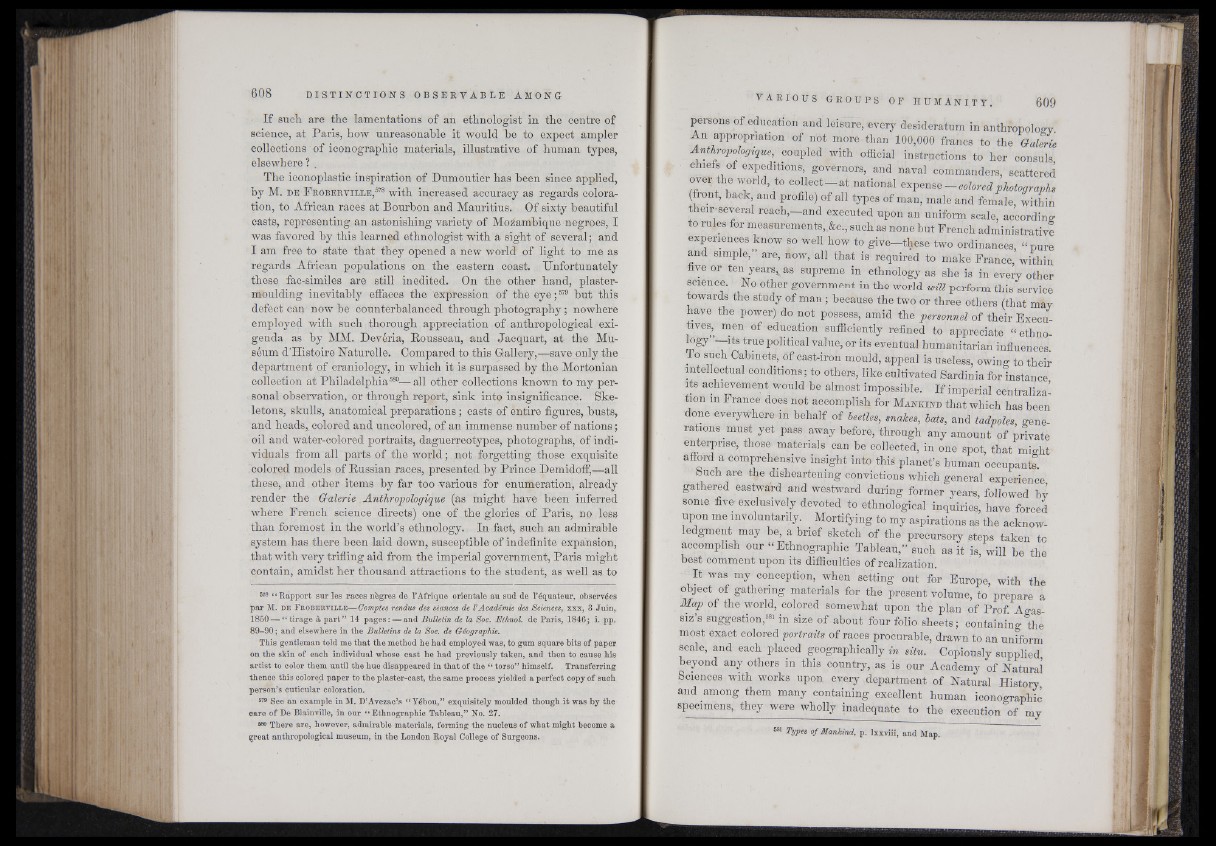
If such are the lamentations of an ethnologist in the centre of
science, at Paris, how unreasonable it would be to expect ampler
collections of iconographie materials, illustrative of human types,
elsewhere? .
The iconoplastic inspiration of Dumoutier has been since applied,
by M. d e F r o b er v ill e ,678 with increased accuracy as regards coloration,
to African races at Bourbon and Mauritius. Of sixty beautiful
casts, representing an astonishing variety of Mozambique negroes, I
was favored by this learned ethnologist with a sight of several ; and
I am free to state that they opened a new world of light to me as
regards African populations on the eastern coast. Unfortunately
these fae-similes are still inedited. On the other hand, plaster-
moulding inevitably effaces the " expression of the eye ;679 but this
defect can now be counterbalanced through photography ; nowhere
employed with such thorough appreciation of anthropological exi-
genda as by MM. Devéria, Rousseau, and Jacquart, at the Muséum
d’Histoire Naturelle. Compared.to this Gallery,—save only the
department of craniology, in which it is surpassed by the Mortonian
collection at Philadelphia580—all other collections known to my personal
observation, or through report, sink into insignificance. Skeletons,
skulls, anatomical preparations ; casts of entire figures, busts,
and heads,, colored and uncolored, of an immense number of nations ;
oil and water-colored portraits, daguerreotypes, photographs, of individuals
from all parts of the world ; pot forgetting those exquisite
colored models of Russian races, presented by Prince Demidoff,—all
these, and other items by far too various for enumeration, already
render tbe G-alerie Anthropologique (as might have been inferred
where French science directs) one of the glories of Paris, no less
than foremost in the world’s ethnology. In fact, such an admirable
system bas there been laid down, susceptible of indefinite expansion,
that with very trifling aid from the imperial government, Paris might
contain, amidst her thousand attractions to the student, as well as to
578 “ Rapport sur les races nègres de l’Afrique orientale au sud de l’équafeur, observées
par M. de F rob e rv ille—Comptes rendus des séances de VAcadémie des Sciences, xxx, 3 Juin,
1850— “ tirage à part” 14 pages: — and Bulletin de la Soc. Ethnol. de Paris, 1846j i. pp.
89-90 ; and elsewhere in the Bulletins de la Soc. de Géographie.
This gentleman told me that the method he had employed was, to gum square bits of paper
on the skin of each individual whose cast he had previously taken, and then to cause his
artist to color them until the hue disappeared in that of the “ torso” himself. Transferring
thence this colored paper to the plaster-cast, the same process yielded a perfect copy of such
person’s cuticular coloration.
679 See an example in M. B’Avezac’s “ Yébou,” exquisitely moulded though it was by the
care of Be Blainville, in our “ Ethnographic Tableau,” No. 27.
680 There are, however, admirable materials, forming the nucleus of what might become a
great anthropological museum, in the London Royal College of Surgeons.
persons of .education and leisure, every desideratum in anthropology
An appropriation of not more than 100,000 francs to tbe Galerie
Anthropologique,' coupled with official instructions to her consuls
c iefs of expeditions, governors, and naval commanders, scattered
over the world to collect—at national expense — colored photograph»
( ront, back, and profile) of all types of man, male and female, within
their-several reach,—and executed upon an uniform scale, according
to rules for measurements,,&c., such as none but French administrative
experiences know so well how to give—these two ordinances, “ pure
and simple,” are, now, all that is required to make France, within
five or ten yearsv as supreme in ethnology as she is in every other
science. No other government in the world will perform this service
towards the study of man; because the two or three others (that may
have the power) do not possess, amid the personnel of their Executives,
men of education sufficiently refined to appreciate “ ethno-
ogy —Ate true political value, or its eventual humanitarian influences
To such Cabinets, of cast-iron mould, appeal is useless, owing to their
intellectual conditions; to others, like cultivated Sardinia for instance
its achievement would be almost impossible. I f imperial centralization
m France does not accomplish for M a n k in d that which has been
done everywhere in behalf of beetles, snakes, bats, and tadpoles, generations
must yet pass away before, through any amount of private
enterprise, those materials can be collected, in one spot, that might
afford a comprehensive insight into this planet’s human occupants.
Such are the disheartening convictions which general experience
gathered eastward and westward during former years, followed by
some five- exclusively devoted to ethnological inquiries, have forced
upon me involuntarily. Mortifying to my aspirations as the acknowledgment
may be, a brief sketch of the precursoiy steps taken to
accomplish our “Ethnographic Tableau,” such as it is, will be the
best comment upon its difficulties of realization.
It was my conception, when setting out for Europe, with the
object of gathering materials for the present volume, to prepare a
Map of the world, colored somewhat upon the plan of Prof Agas
siz’s suggestion,581 in size of about four folio sheets; containing the
most exact colored portraits of races procurable, drawn to an uniform
scale, and each placed geographically in situ. Copiously supplied
beyond any others in this country, as is our Academy of Natural
Sciences with works upon every department of Natural History
and among them many containing excellent human monographic
specimens, they were wholly inadequate to the execution of my
581 Types of Mankind, p. lxxyiii, and Map.